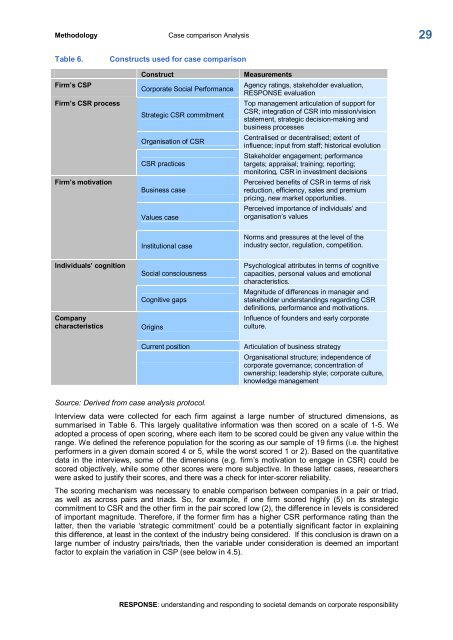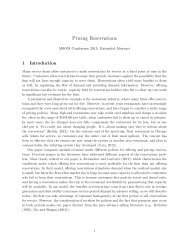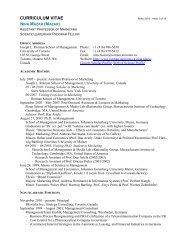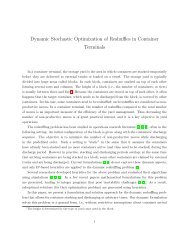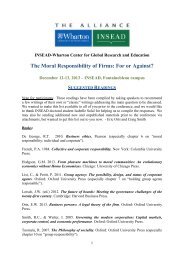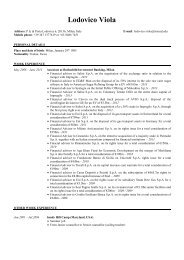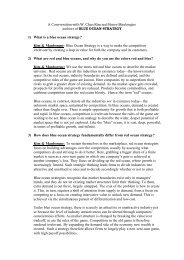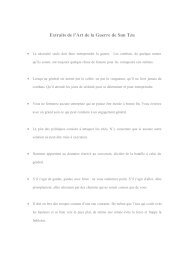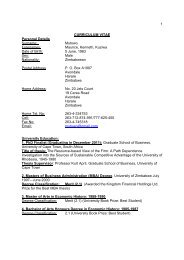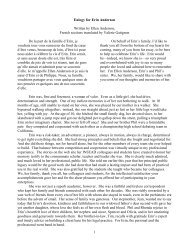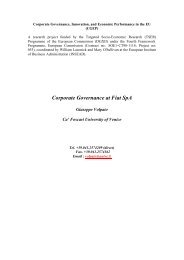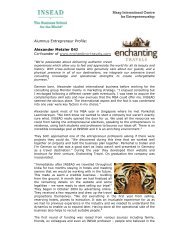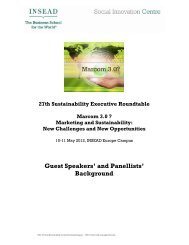RESPONSE - Insead
RESPONSE - Insead
RESPONSE - Insead
Create successful ePaper yourself
Turn your PDF publications into a flip-book with our unique Google optimized e-Paper software.
Methodology Case comparison Analysis<br />
Table 6. Constructs used for case comparison<br />
Firm’s CSP<br />
Firm’s CSR process<br />
Firm’s motivation<br />
Individuals’ cognition<br />
Company<br />
characteristics<br />
Construct Measurements<br />
Corporate Social Performance<br />
Strategic CSR commitment<br />
Organisation of CSR<br />
CSR practices<br />
Business case<br />
Values case<br />
Institutional case<br />
Social consciousness<br />
Cognitive gaps<br />
Origins<br />
Source: Derived from case analysis protocol.<br />
Agency ratings, stakeholder evaluation,<br />
<strong>RESPONSE</strong> evaluation<br />
Top management articulation of support for<br />
CSR; integration of CSR into mission/vision<br />
statement, strategic decisionmaking and<br />
business processes<br />
Centralised or decentralised; extent of<br />
influence; input from staff; historical evolution<br />
Stakeholder engagement; performance<br />
targets; appraisal; training; reporting;<br />
monitoring, CSR in investment decisions<br />
Perceived benefits of CSR in terms of risk<br />
reduction, efficiency, sales and premium<br />
pricing, new market opportunities.<br />
Perceived importance of individuals’ and<br />
organisation’s values<br />
Norms and pressures at the level of the<br />
industry sector, regulation, competition.<br />
Psychological attributes in terms of cognitive<br />
capacities, personal values and emotional<br />
characteristics.<br />
Magnitude of differences in manager and<br />
stakeholder understandings regarding CSR<br />
definitions, performance and motivations.<br />
Influence of founders and early corporate<br />
culture.<br />
Current position Articulation of business strategy<br />
Organisational structure; independence of<br />
corporate governance; concentration of<br />
ownership; leadership style; corporate culture,<br />
knowledge management<br />
Interview data were collected for each firm against a large number of structured dimensions, as<br />
summarised in Table 6. This largely qualitative information was then scored on a scale of 15. We<br />
adopted a process of open scoring, where each item to be scored could be given any value within the<br />
range. We defined the reference population for the scoring as our sample of 19 firms (i.e. the highest<br />
performers in a given domain scored 4 or 5, while the worst scored 1 or 2). Based on the quantitative<br />
data in the interviews, some of the dimensions (e.g. firm’s motivation to engage in CSR) could be<br />
scored objectively, while some other scores were more subjective. In these latter cases, researchers<br />
were asked to justify their scores, and there was a check for interscorer reliability.<br />
The scoring mechanism was necessary to enable comparison between companies in a pair or triad,<br />
as well as across pairs and triads. So, for example, if one firm scored highly (5) on its strategic<br />
commitment to CSR and the other firm in the pair scored low (2), the difference in levels is considered<br />
of important magnitude. Therefore, if the former firm has a higher CSR performance rating than the<br />
latter, then the variable ‘strategic commitment’ could be a potentially significant factor in explaining<br />
this difference, at least in the context of the industry being considered. If this conclusion is drawn on a<br />
large number of industry pairs/triads, then the variable under consideration is deemed an important<br />
factor to explain the variation in CSP (see below in 4.5).<br />
<strong>RESPONSE</strong>: understanding and responding to societal demands on corporate responsibility<br />
29


